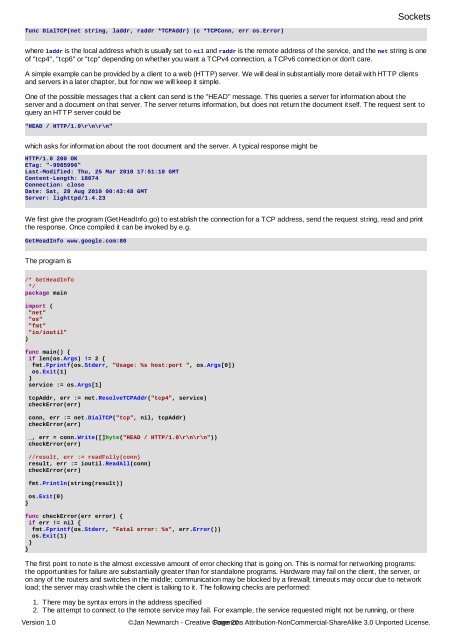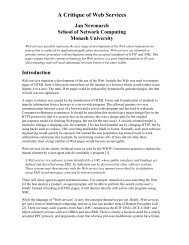Network Programming with Go - Jan Newmarch
Network Programming with Go - Jan Newmarch
Network Programming with Go - Jan Newmarch
Create successful ePaper yourself
Turn your PDF publications into a flip-book with our unique Google optimized e-Paper software.
func DialTCP(net string, laddr, raddr *TCPAddr) (c *TCPConn, err os.Error)<br />
where laddr is the local address which is usually set to nil and raddr is the remote address of the service, and the net string is one<br />
of "tcp4", "tcp6" or "tcp" depending on whether you want a TCPv4 connection, a TCPv6 connection or don't care.<br />
A simple example can be provided by a client to a web (HTTP) server. We will deal in substantially more detail <strong>with</strong> HTTP clients<br />
and servers in a later chapter, but for now we will keep it simple.<br />
One of the possible messages that a client can send is the "HEAD" message. This queries a server for information about the<br />
server and a document on that server. The server returns information, but does not return the document itself. The request sent to<br />
query an HTTP server could be<br />
"HEAD / HTTP/1.0\r\n\r\n"<br />
which asks for information about the root document and the server. A typical response might be<br />
HTTP/1.0 200 OK<br />
ETag: "-9985996"<br />
Last-Modified: Thu, 25 Mar 2010 17:51:10 GMT<br />
Content-Length: 18074<br />
Connection: close<br />
Date: Sat, 28 Aug 2010 00:43:48 GMT<br />
Server: lighttpd/1.4.23<br />
We first give the program (GetHeadInfo.go) to establish the connection for a TCP address, send the request string, read and print<br />
the response. Once compiled it can be invoked by e.g.<br />
GetHeadInfo www.google.com:80<br />
The program is<br />
/* GetHeadInfo<br />
*/<br />
package main<br />
import (<br />
"net"<br />
"os"<br />
"fmt"<br />
"io/ioutil"<br />
)<br />
func main() {<br />
if len(os.Args) != 2 {<br />
fmt.Fprintf(os.Stderr, "Usage: %s host:port ", os.Args[0])<br />
os.Exit(1)<br />
}<br />
service := os.Args[1]<br />
tcpAddr, err := net.ResolveTCPAddr("tcp4", service)<br />
checkError(err)<br />
conn, err := net.DialTCP("tcp", nil, tcpAddr)<br />
checkError(err)<br />
_, err = conn.Write([]byte("HEAD / HTTP/1.0\r\n\r\n"))<br />
checkError(err)<br />
//result, err := readFully(conn)<br />
result, err := ioutil.ReadAll(conn)<br />
checkError(err)<br />
fmt.Println(string(result))<br />
os.Exit(0)<br />
}<br />
func checkError(err error) {<br />
if err != nil {<br />
fmt.Fprintf(os.Stderr, "Fatal error: %s", err.Error())<br />
os.Exit(1)<br />
}<br />
}<br />
The first point to note is the almost excessive amount of error checking that is going on. This is normal for networking programs:<br />
the opportunities for failure are substantially greater than for standalone programs. Hardware may fail on the client, the server, or<br />
on any of the routers and switches in the middle; communication may be blocked by a firewall; timeouts may occur due to network<br />
load; the server may crash while the client is talking to it. The following checks are performed:<br />
1. There may be syntax errors in the address specified<br />
2. The attempt to connect to the remote service may fail. For example, the service requested might not be running, or there<br />
Sockets<br />
Version 1.0 ©<strong>Jan</strong> <strong>Newmarch</strong> - Creative Commons Page 20 Attribution-NonCommercial-ShareAlike 3.0 Unported License.




